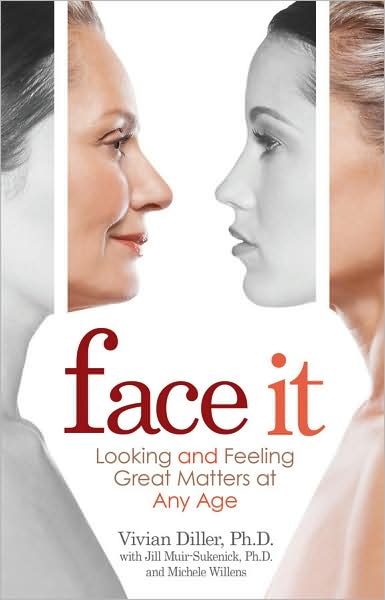I have been wanting to read this book for a long time, so I was interested to see this brief summary at Psych Central, one of my regular reads. The authors are both psychologists and former models, and now in their 50’s. They wrote about how to cope with the changes that aging brings to our self-image.
I’ve quoted from the article below, and added my own commentary (in italics). As always, I’d love to hear from you in the comments.
“How do women escape the judgment conferred on them every time they open a magazine, get online, or turn on the tube?” Very deliberately and carefully, say Vivian Diller, Ph.D and Jill Muir-Sukenick, Ph.D, in their book, Face It: What Women Really Feel as Their Looks Change. The authors propose six steps.
- “Step one: Confront our changing looks. The authors call them ‘uh oh’ moments: when you notice your first wrinkles, smile lines, graying and thinning hair, darkening circles below the eyes, varicose veins, brown spots on hands and face, loss of muscle tone, hanging skin on arms or neck, and hot flashes. Me: Oh yes, the uh-oh moments. Mine often come when I see a candid picture of myself or catch myself off-guard in a rear-view mirror
- “Step two: Identify our masks. Diller and Muir-Sukenick mean the ways we hide from or avoid our fears by layers of protection that, in reality, make us look ridiculous. Like, for example, deciding to wear our daughters’ clothes to work, in order to prove to ourselves that we, too, can wear a size six, and that our body looks like an 18-year-old’s. Me: I favor our right to dress as we wish, without recrimination. But I also favor reality over denial. It’s not realistic that I look 25 years old, no matter how mini my skirt is.
- “Step three: Listen to our inner dialogues. It’s an ongoing conversation within us that we are, most of the time, oblivious to. But the rest of the body hears the dialog and registers the message: You’re old, fat, ugly, and useless. Me: We have to practice talking to ourselves the way we talk to loved ones. We’d be so much kinder.
- “Step four: Go back in time to your earliest messages. It’s helpful to know where your self-image is coming from, because only then can we redesign it based on what we know about ourselves. Me: We can write our own scripts now, that reflect our reality and have nothing to do with Mother’s and Father’s pronouncements. Freedom!
- “Step five: Consider our adolescence. No, you might say – I buried those scars long ago. The authors suggest there are parallels between gray-hair anxiety and the awkwardness we went through as adolescents. Me: remember that we’ve survived transitions, and are creating a new way of life.
- “Step six: is to let go. To mourn the youthful part of ourselves that is embedded into our memories. It’s about coming up with a new meaning of beauty, a new definition of ‘youthful,’ one that, perhaps, doesn’t require a plastic surgeon, but just a lot of raw and candid self-exploration and acceptance.” Me: as Mr J said, We are not worse! Only different. And not dead yet.
 |
| Photo by Mr J, on my 60th birthday, with the beautiful Judith. |
Stay fabulous, xo




Thanks for sharing this, Patti! Looks like a very interesting read. I feel as though my 50’s have been about coming to terms with my changing looks and the aging process. I can honestly say that today I feel more comfortable with that intersection of who I am and what I look like than at any other time in my life.